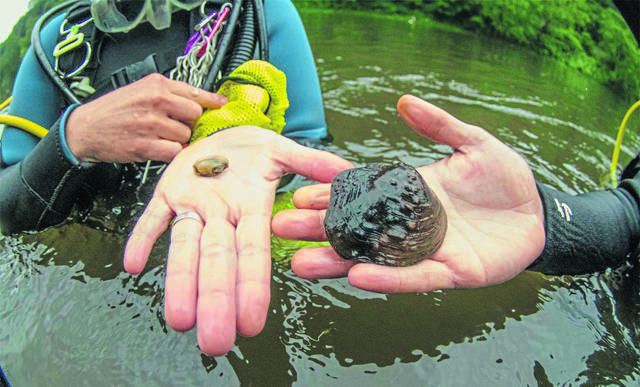https://triblive.com/opinion/editorial-the-triumph-of-a-healthy-kiski-river-bulging-with-mussels/
Editorial: The triumph of a healthy Kiski River, bulging with mussels

Is anything ever too far gone to be redeemed?
A freshwater shellfish says no.
The Kiski River was so polluted for so long with the runoff from mining and the discharge from industry, it seemed too far gone to ever be home to life again. In 1909, A.E. Ortmann, curator of invertebrate zoology at the Carnegie Museum, pronounced it dead, saying all freshwater life in the river was extinct.
He was right. For about 100 years, at least.
Today, the river is alive again.
Western Pennsylvania Conservancy divers have found evidence of the resurgence of eight species of freshwater mussels that haven’t been seen in the Kiski’s waters since at least Ortmann’s survey. In Sunday’s Tribune-Review, writer Mary Ann Thomas and photographer Louis Ruediger chronicled the divers’ work and their plans to keep exploring the river; on TribLive.com, Ruediger presents an underwater video that takes you right down to the riverbed, where you can see the mussels hard at work. “Mussels are nature’s filter feeders,” said Eric Chapman, lead diver and director of aquatic science for the Western Pennsylvania Conservancy. “It’s an ecosystem service to humans, where we are getting filtered water, for free.”
Some of the mussel species — with evocative names like fat mucket, fragile papershell and pink heelsplitter — appeared to have come back as long as 20 years ago. The researchers also are finding juvenile mussels, which shows that reproduction is happening. That demonstrates how much decades of effort to reduce the pollution has worked. Springdale native Rachel Carson, the mother of the conservation movement, would be proud.
If a mussel — a creature that can’t exactly pack up its stuff and relocate when its habitat turns inhospitable — can set up shop again in the once murky waters, there has to be potential for people to find ways to improve their own living conditions.
And that’s the kind of hope we need now. Not hope that a bad event can ultimately end in a happily ever after. No. Hope that no matter how bad bad gets, it can be turned around with cooperation, hard work and time.
When an entire river is written off as dead, that seems pretty hopeless. What point is there in trying to reduce the pollution if the pollution already has destroyed the water? Why not give up and let the status quo roll on?
Because there was a way to get back what was lost.
It took a lot of work. It meant building treatment ponds to divert acid mine drainage and sift out metals, raising the pH levels to a more neutral level.
It took political will, over decades, to establish and enforce the Clean Water Act and the regulations of the Environmental Protection Agency.
It took a lot of people, and it took money. But more than anything, it took commitment to an idea that at one point had to seem hopeless.
Copyright ©2025— Trib Total Media, LLC (TribLIVE.com)
